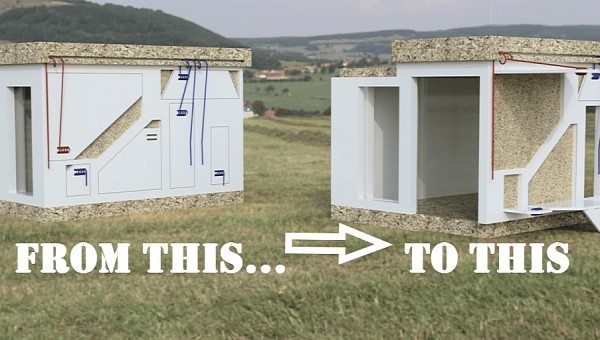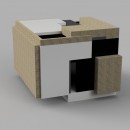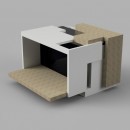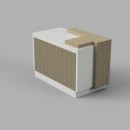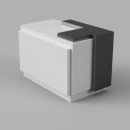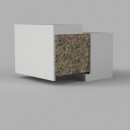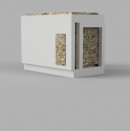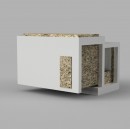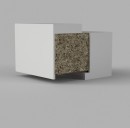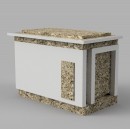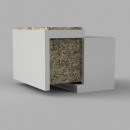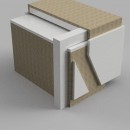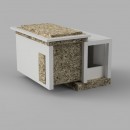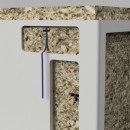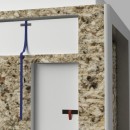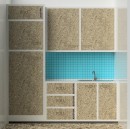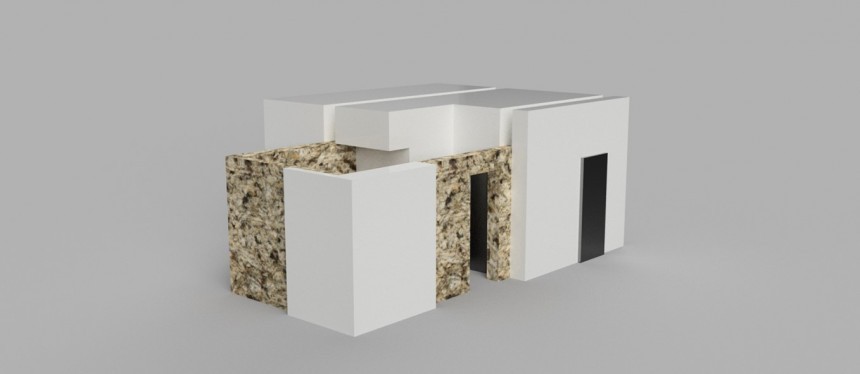No one can tell for certain what the future of housing holds for today’s digital nomad, but what’s stopping us from trying to make an educated guess? We only have to look at existing options out there, including tiny houses, a variety of mobile homes and habitats, and prefabs.
The Picnic would be one such educated guess. It’s a microhome that tackles the issue of alternative living solutions through a very compact footprint and enhanced functionality. The Picnic is only a concept for the time being and, while looking at concepts might seem pointless when we have so many options already built and being used extensively, it serves an excellent purpose – that of showing just how much you can achieve with so little.
The very premise of a tiny house is just that, if you think about it: that of offering a compact footprint with almost all, if not all creature comforts of a proper home, to downsize. Whether done for financial reasons or environmental considerations, or simply in order to achieve more freedom of movement, downsizing is very popular with digital nomads from all over the world, fueling two of the hottest trends today: tiny living and vanlife.
The Picnic takes the idea of downsizing to the extreme, by adding modularity and taking inspiration from the age-old picnic box. It’s an unexpected association, but it works, we promise. Designed in 2021-2022 as a response to a competition on microhome architecture for young architects, it is the brainchild of Croatian designer Mauro Polondak, in collaboration with Mihaela Klobucar and Magdalena Kacan, his colleagues from the Faculty of Architecture.
The Picnic is comparable to some of the tiniest prefabs out there (think Boxabl’s Casita, which even billionaire Elon Musk fell in love with after buying a prototype that he occasionally uses as a sleepover pad), but it has modularity. Its basis is a box, but it folds out in a variety of ways, for seemingly endless configurations. Add extra modules, and you get even more functionality out of this very compact unit.
The idea of a transformable tiny home is not new, and it’s already been used to great success – and even greater popularity. The ANNA Stay cabin by Dutch designer Caspar Schols can adapt to all seasons and weather conditions by adding and removing “layers,” and even has slide-outs that open its middle section completely to the exterior. Perhaps more spectacular is the Casa Ojalá project, by architect Beatrice Bonzanigo, who found inspiration in boat design to create a circular structure that allows for over 1,000 permutations to the original layout, through a system of rollers and hinges.
Polondak doesn’t say how many configurations Picnic offers but renders show a great number of them. The prefab is modular both on the outside and on the inside, so depending on the owner and whatever use they have in mind for it, it can expand and adapt to those needs, by adding extra space, extra decking, extra windows, you name it. It’s like a picnic box that hides countless surprise compartments, with the exception that the owner would know exactly what these are and what purpose they serve.
Depending on which space is being used, the Picnic microhome changes appearance, and contrasting panels add extra personality to the structure, while also holding clues about the function and operation of certain parts. Polondak uses different color schemes, colored strings, and simple lettering to hint at the double functionality of parts, but he’s able to still keep the design uncluttered and minimalist.
This “interactive” design also adds a fun element to a housing unit, because it means residents won’t have a static design to deal with on an everyday basis. It’s like a Lego house, one which you can play with, while living full-time inside.
Since it comes with a solid base and a very compact form factor, the implication is that Picnic is lightweight to be moved around frequently, again in concordance with the lifestyle and the needs of the owner. Plop it on a trailer with a small crane, and you got yourself a tiny house that you can tow to your next location, where you’ll be working from home. It’s true, the solution is less convenient than a tiny house or a van/bus conversion, but admittedly adds extra functionality.
As stated above, there’s no way to accurately predict how the mobile home of tomorrow might end up looking like, but it’d be great if it was anything close to the Picnic.
Tiny houses, which have seen such an incredible surge in popularity over the past couple of years, do have the major downside of a prohibitive price tag, which prefabs usually don’t. In other words, Picnic would be the best of both worlds: the movability and comfort of a tiny, with a more affordable price of a prefab.
The very premise of a tiny house is just that, if you think about it: that of offering a compact footprint with almost all, if not all creature comforts of a proper home, to downsize. Whether done for financial reasons or environmental considerations, or simply in order to achieve more freedom of movement, downsizing is very popular with digital nomads from all over the world, fueling two of the hottest trends today: tiny living and vanlife.
The Picnic takes the idea of downsizing to the extreme, by adding modularity and taking inspiration from the age-old picnic box. It’s an unexpected association, but it works, we promise. Designed in 2021-2022 as a response to a competition on microhome architecture for young architects, it is the brainchild of Croatian designer Mauro Polondak, in collaboration with Mihaela Klobucar and Magdalena Kacan, his colleagues from the Faculty of Architecture.
The idea of a transformable tiny home is not new, and it’s already been used to great success – and even greater popularity. The ANNA Stay cabin by Dutch designer Caspar Schols can adapt to all seasons and weather conditions by adding and removing “layers,” and even has slide-outs that open its middle section completely to the exterior. Perhaps more spectacular is the Casa Ojalá project, by architect Beatrice Bonzanigo, who found inspiration in boat design to create a circular structure that allows for over 1,000 permutations to the original layout, through a system of rollers and hinges.
Polondak doesn’t say how many configurations Picnic offers but renders show a great number of them. The prefab is modular both on the outside and on the inside, so depending on the owner and whatever use they have in mind for it, it can expand and adapt to those needs, by adding extra space, extra decking, extra windows, you name it. It’s like a picnic box that hides countless surprise compartments, with the exception that the owner would know exactly what these are and what purpose they serve.
This “interactive” design also adds a fun element to a housing unit, because it means residents won’t have a static design to deal with on an everyday basis. It’s like a Lego house, one which you can play with, while living full-time inside.
Since it comes with a solid base and a very compact form factor, the implication is that Picnic is lightweight to be moved around frequently, again in concordance with the lifestyle and the needs of the owner. Plop it on a trailer with a small crane, and you got yourself a tiny house that you can tow to your next location, where you’ll be working from home. It’s true, the solution is less convenient than a tiny house or a van/bus conversion, but admittedly adds extra functionality.
Tiny houses, which have seen such an incredible surge in popularity over the past couple of years, do have the major downside of a prohibitive price tag, which prefabs usually don’t. In other words, Picnic would be the best of both worlds: the movability and comfort of a tiny, with a more affordable price of a prefab.
